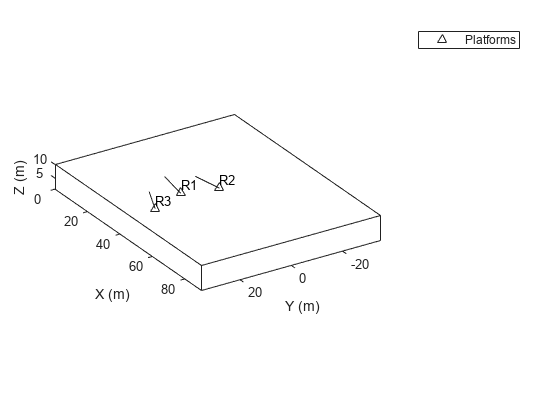platformPlotter
Create platform plotter
Description
pPlotter = platformPlotter(tp)tp.
pPlotter = platformPlotter(tp,Name,Value)Name,Value pair arguments.
Examples
Create a theater plot.
tp = theaterPlot('XLim',[0,90],'YLim',[-35,35],'ZLim',[1,10]);
Create a platform plotter with the name 'Platforms'.
plotter = platformPlotter(tp,'DisplayName','Platforms');
Update the theater plot with three platforms labeled, 'R1', 'R2', and 'R3'. Position the three platforms, in units of meters, at , , and , with corresponding velocities (in m/s) of , , and , respectively.
positions = [30, 5, 4; 30, -10, 2; 30, 15, 1];
velocities = [-10, 0, 2; -10, 3, 1; -10, -4, 1];
labels = {'R1','R2','R3'};
plotPlatform(plotter, positions, velocities, labels);Change the view angles to view in 3-D.
view([-57.7 -25.9]);

Input Arguments
Theater plot, specified as a theaterPlot
object.
Name-Value Arguments
Specify optional pairs of arguments as
Name1=Value1,...,NameN=ValueN, where Name is
the argument name and Value is the corresponding value.
Name-value arguments must appear after other arguments, but the order of the
pairs does not matter.
Before R2021a, use commas to separate each name and value, and enclose
Name in quotes.
Example: 'MarkerSize',10
Plot name to display in legend, specified as the comma-separated pair consisting of 'DisplayName' and a character vector or string scalar. If no name is specified, no entry is shown.
Example: 'DisplayName','Radar Detections'
Marker symbol, specified as the comma-separated pair consisting of
'Marker' and one of these values.
| Marker | Description | Resulting Marker |
|---|---|---|
"o" | Circle |
|
"+" | Plus sign |
|
"*" | Asterisk |
|
"." | Point |
|
"x" | Cross |
|
"_" | Horizontal line |
|
"|" | Vertical line |
|
"square" | Square |
|
"diamond" | Diamond |
|
"^" | Upward-pointing triangle |
|
"v" | Downward-pointing triangle |
|
">" | Right-pointing triangle |
|
"<" | Left-pointing triangle |
|
"pentagram" | Pentagram |
|
"hexagram" | Hexagram |
|
"none" | No markers | Not applicable |
Size of marker, specified as the comma-separated pair consisting of
'MarkerSize' and a positive integer in points.
Marker outline color, specified as the comma-separated pair consisting of
'MarkerEdgeColor' and a character vector, a string scalar, an
RGB triplet, or a hexadecimal color code.
Marker outline color, specified as the comma-separated pair consisting of
'MarkerFaceColor' and a character vector, a string scalar, an
RGB triplet, a hexadecimal color code, or 'none'. The default is
'none'.
Font size for labeling platforms, specified in font points size as the
comma-separated pair consisting of 'FontSize' and a positive
integer.
Gap between label and positional point it annotates, specified as the
comma-separated pair consisting of 'LabelOffset' and a
three-element row vector. Specify the [x
y
z] offset in meters.
Scale factor for magnitude length of velocity vectors, specified as the
comma-separated pair consisting of 'VelocityScaling' and a
positive scalar. The plot renders the magnitude vector value as VK,
where V is the magnitude of the velocity in meters per second, and
K is the value of VelocityScaling.
Tag to associate with the plotter, specified as the comma-separated pair
consisting of 'Tag' and a character vector or string scalar. The
default value is 'PlotterN', where
N is an integer that corresponds to the Nth
plotter associated with the theaterPlot.
Tags provide a way to identify plotter objects, for example when searching using
findPlotter.
Version History
Introduced in R2018b
See Also
MATLAB Command
You clicked a link that corresponds to this MATLAB command:
Run the command by entering it in the MATLAB Command Window. Web browsers do not support MATLAB commands.
选择网站
选择网站以获取翻译的可用内容,以及查看当地活动和优惠。根据您的位置,我们建议您选择:。
您也可以从以下列表中选择网站:
如何获得最佳网站性能
选择中国网站(中文或英文)以获得最佳网站性能。其他 MathWorks 国家/地区网站并未针对您所在位置的访问进行优化。
美洲
- América Latina (Español)
- Canada (English)
- United States (English)
欧洲
- Belgium (English)
- Denmark (English)
- Deutschland (Deutsch)
- España (Español)
- Finland (English)
- France (Français)
- Ireland (English)
- Italia (Italiano)
- Luxembourg (English)
- Netherlands (English)
- Norway (English)
- Österreich (Deutsch)
- Portugal (English)
- Sweden (English)
- Switzerland
- United Kingdom (English)